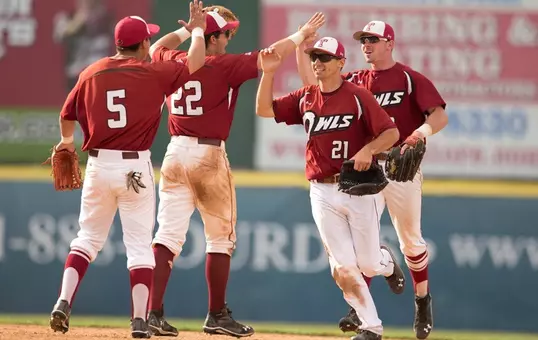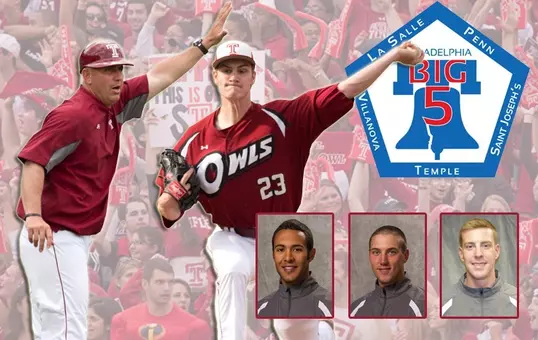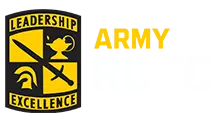Temple University Athletics
A History of Temple Baseball 1927-2006
1.4.07 | Baseball
Jan. 4, 2007
PHILADELPHIA - The Temple baseball program enters its 80th season in 2007 as the most successful in the city of Philadelphia and owns one of the region's most storied traditions. The Owls boast a pair of College World Series appearances, 14 NCAA trips, 12 conference championships and over 1,300 wins since making their debut in 1927. The program has produced 24 MLB draft picks and nearly 60 professional players, including 13 to make the big leagues.
Under head coach Frank Martin, the Cherry and White compiled a 5-12 record in its first season in 1927. Martin gave way to Walter Keating, who recorded a 39-34 record in four seasons as the Owls took on local colleges and athletics clubs. Ralph "Pep" Young succeeded Martin and collected 110 wins in his 11 year career, including a program best 16-2 season in 1941. TU was led by future Temple Hall of Famers and two-sport athletes Jimmy Brown, Jim Honochick, Angelo Musi, George Nemchick, George Patton and Andy Tomasic, many of whom also gained fame for the Temple football team.
Harold Williams and Ernie Messikomer each coached a season, sandwiching a two-year hiatus (1944-45) when the program was discontinued during World War II. Future Owl gridiron coach Pete Stevens guided the program from 1947-52 before giving way to Ernie Casale.
The future Temple Athletic Director directed his team to a pair of NCAA Tournament appearances in 1957 and 1959. The 1959 team was the first to play in the Middle Atlantic Conference and proceeded to compile a 10-2 record in the league on its way to the conference title. Bill "Pickles" Kennedy highlighted the end of the 1950s as the All-American centerfielder batted .414 and was signed as a free agent with the Pittsburgh Pirates. Also an All-American in basketball, he was drafted by the NBA's Philadelphia Warriors.
Casale gave way to assistant coach James "Skip" Wilson in 1960, who would take the program to new heights. In his fourth season in 1963, the Owls went 20-3 and 10-0 in the MAC University Division to make their third NCAA trip and first under Wilson. TU was also ranked for the first time in program history, finishing #13 by Collegiate Baseball. Temple continued to finish near the top of the division, but did not return to the NCAA Tournament until 1968.
That season, TU went 25-6 overall and 10-3 in the league to capture its first outright MAC Championship. Temple also won its first NCAA Tournament game, defeating NYU, 6-5, before dropping two straight to fall short of a College World Series trip. Les Roos set a new program record with a .457 batting average that season which still stands. Hal Werntz, who had already been drafted twice before by Kansas City in 1966 and the New York Yankees in 1967, returned for his senior season and was 9-2 with a 1.81 ERA.
The program had certainly seen its share of success up until that point in time but beginning in 1972, the Owls stacked up with some of the nation's top programs. From 1972-84, Temple made nine NCAA trips, including two to the College World Series, and won 12 conference championships in 13 years. The composite record during that time was a staggering 380-157-4 (.706).
Temple reached the College World Series in 1972 after sweeping through the NCAA District II Tournament with a 3-0 record. The Owls opened the CWS with a heartbreaking 2-1 loss to Oklahoma in 13 innings but bounced back to eliminate Iowa, 13-9. After sending Connecticut home, Temple faced off with Arizona State for the chance to play USC in the finals. Featuring a roster stacked with seven future major leaguers, the Sun Devils edged the Owls, 1-0. The third place national finish is the best ever in the program's history.
As a sophomore, Mike Arace was the ace of the staff, posting a 7-2 record and a 1.76 ERA. Ed Molush, who signed with the Philadelphia Phillies following the season, was 7-4 with a 2.72 ERA. Earle Chew, who would be selected in the third round of the 1973 draft, batted .304 with five homers and 46 RBI to help the Cherry and White to the World Series.
The next season, Temple recorded a 33-11 record and won the MAC again but came up one game short at regionals and was denied a second straight trip to Omaha. Rich Casale had one of the best seasons by an Owl pitcher, going 8-1 and setting a new school record with a 1.15 ERA in 62.2 innings.
The Owls struggled in 1974, failing to win a league crown for the only time during the 13 year run, but the season was not devoid of personal highlights. Joe Kerrigan, who went on to a successful career as a major league pitching coach, became the highest Temple draft pick, going tenth overall to Montreal.
The Cherry and White won the first of four straight East Coast Conference Championships in 1975 but was eliminated in the South Atlantic Regional in three games. The 1976 team won a school record 37 games, against just eight losses, but fell short in the NCAA Northeast Regional.
The Owls made it back to the College World Series in 1977, led by star SS Pete Dempsey, who batted .404 with 10 home runs and 55 RBI. As a team, Temple batted a program record .353 with all nine starters batting at least .315. Future major leaguer Pete Filson was 5-0 with a 3.28 ERA as a sophomore and Jay Hallman (10-0, 3.70) and Bob Steele (10-2, 2.54) set a school record with 10 wins.
Temple swept through the Northeast Regional with a 4-0 record and scored an average of nine runs a game. But the bats went silent in the College World Series and the Owls finished eighth overall. Six players went on to careers in professional baseball from the 1977 team, including five who were drafted.
Most of the team returned in 1978 and the Owls returned to the NCAA Tournament after winning their fourth straight ECC title. Junior 2B Rod Johnson earned All-America honors after batting .439 with six homers and 34 RBI and teamed with Dempsey (.319, 7 HR, 53 RBI) to form one of the nation's top middle infields. The Owls set new program records for runs scored and homers, as six players slugged six or more dingers.
The Cherry and White won its first three games at the NCAA Northeast Regional, but dropped two straight to St. John's to see its Omaha dreams shattered. Dempsey (sixth round, Phillies) and Jim Beck (16th round, Mets) were drafted following the season.
In 1979, Temple went 23-5 overall and 10-0 in the ECC. It marked the third straight season that the Owls were undefeated in the league and won the ECC East Division. A two-and-out showing at the ECC Tournament kept the Owls out of the NCAA Tournament for the first time in five years. Johnson batted .432 and finished his career with a .399 average, which was a program-best when he graduated. Hallman ended his career with 24 wins, also setting a program record. Three Owls (Filson, Paul Niggebrugge and Johnson) were selected in the MLB Draft.
The 32-game ECC winning streak came to an end in 1980, but Temple still went 26-18 and won the ECC East Division. Delaware kept the Owls out of the NCAA Tournament for the second straight year, but TU returned in 1981. The Cherry and White won the ECC, but dropped two games in the NCAA Tournament.
Temple won the ECC East in its final season in the conference in 1982 and moved into the Atlantic 10 Conference in 1983. The A-10 quickly learned that the Owls would be a force to reckon with, as the newcomers won the conference title in 1983 and 1984 and made trips to the NCAA Tournament. Those teams were led by a trio of Temple Hall of Fame players, two who would go onto careers in the major leagues.
John Marzano, a first round draft pick and member of the gold medal winning U.S. Olympic team in 1984, finished his career with a .413 average, good for tops all-time. An All-American by three different organizations in 1984, Marzano batted .448 with 15 home runs and 61 RBI. He finished his career as the all-time leader in batting average, slugging percentage and home runs. Marzano played 10 seasons in the big leagues with Boston and Seattle.
Jeff Manto, who came to Temple as a pitcher, batted .378 in 1984 and .442 with 16 homers and 60 RBI in 1985. He was drafted in the 14th round by the California Angels and played nine seasons in the big leagues. Manto is now the hitting coach for the Pittsburgh Pirates.
Bill Mendek was the ace of the 1983 and 1984 Atlantic 10 Championship teams, compiling a 30-11 record and 2.57 ERA during his career. When he graduated, he held five school records (wins, saves, appearances, innings and strikeouts). He was drafted in the ninth round of the 1984 MLB Draft by Seattle.
Temple would qualify for the Atlantic 10 Tournament three more times in the 1980s, but did not return to the NCAA Tournament. Another future major leaguer, Bobby Higginson, made his debut in 1989. He earned All-America honors in 1991 (.404, 15 HR, 56 RBI) and 1992 (.405, 11 HR, 50 RBI) and finished his career as the all-time leader in round trippers (30). Higginson was drafted twice at Temple and went onto a 12-year career with the Detroit Tigers.
The Owls made three trips to the A-10 Tournament in the 1990s and had several impressive personal accolades. Rick Martinez set a new school record with 17 homers in 1997, while Peter Moore finished his career as one of the top two-way players in program history. He earned A-10 Pitcher of the Year honors in 1999 and set new school records for saves, appearances, complete games, shutouts, innings and strikeouts. Moore also spent time as a catcher, batting .298 with 130 career hits.
After starting out with a 0-14 record, Temple rebounded to go 27-17 the rest of the way and win the A-10 Tournament in 2001. The Owls returned to the NCAA Tournament for the first time since 1984. Rob Cucinotta broke Higginson's record for career homeruns with 31 and signed a free agent contract with the Boston Red Sox. Bob Filler set the all-time hits record with 234 that same season.
Temple had success in the annual Liberty Bell Classic, an eight-team tournament from the Division I teams in the Philadelphia area. TU won the Liberty Bell Classic title in 1996, 2000 and 2003 at Veterans Stadium and was the runners-up in 2001 and 2002.
The Owls moved to a new home in 2004 on the Temple-Ambler Campus after spending the first 78 years at Erny Field in Cheltenham. Temple defeated University of the Sciences, 6-2, on March 25, 2004 in the opener.
Wilson retired following the 2005 season after 1,034 wins and is the winningest coach in Temple history, regardless of sport. His 46-year tenure was the longest in Division I history when he retired. A three-time District Coach of the Year (1972, 1977, 1978), Wilson was inducted into the Temple, ABCA and Pennsylvania Sports Hall of Fames. The baseball field on the Ambler Campus was named Skip Wilson Field in 2006.
Rob Valli, who led Gloucester County College to the 2005 NJCAA National Championship, was named Wilson's successor in the fall of 2005. He led GCC to the NJCAA World Series each of the five years he was at the helm of the program.















